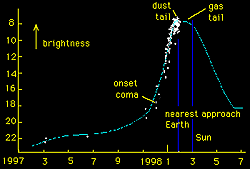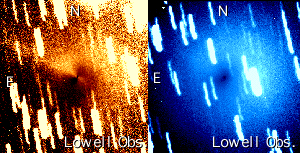|
Leonid MAC |
| home |
| View the shower |
| Mission Brief |
| Science Update |
| Media Brief |
| links |
|
Observations and facts
on the Leonid shower parent comet
COMET BRIGHTNESS AND APPEARANCE In November of 1997, the comet was still a simple point of light in even the biggest telescopes and was lagging brightness predictions, being no more than magnitude +18. The comet was expected to reach magnitude +9.5 in January of 1998. On December 24, a coma was detected, the first sign of activity. After that, the comet brightness rapidly increased and peaked around +7.7 at the time of closest approach with Earth, making it a binocular object for the better say 9x63mm binoculars. Some even detected it in a 7x50 binoculars. The comet remained very diffuse, with a degree of condensation (on a scale of 10) of only DC = 1-3. The comet was closest to Earth on January 17th, when the aparent motion among the stars was most rapid. Shortly after that, a dust tail was detected, which was the most notable feature in mid February. The motion of the dust jet allowed researchers to establish a rotation period of 15.33ÿý0.02 hours. While approaching the Sun and moving away from Earth, the comet coma became less diffuse. The comet reached the point nearest to the Sun on February 28th and rapidly fainted in March. R.O. Hainout et al. derived a diameter of 3.6 kilometers for the nucleus of 55P/Tempel-Tuttle from the brightness of the comet during discovery. Jean Lecacheux, Eric Frappa and Francois Colas report a rotation period of 15.33 +/- 0.02 hours. ORBIT OF THE COMET The latest post-discovery orbital elements of P/Tempel-Tuttle were derived from 468 observations over the period 1865 December 21 to 1998 July 5 and are posted at the Cometary notes of Bureau des Longitudes (note no. 0160). Elements for some previous transits are given also. For the 1998 encounter, they give (in Equinox J2000): -------------------------------------------------------------------------- Epoch: Epoch = 1998 Mar. 8.0 TT (JDT = 2450880.5) Perihelion passage: T = 1998, February 28.09653 +/-0.00005 (m.e.) TT perihelion distance: q = 0.9765889 +/- 0.0000005 AU eccentricity: e = 0.9055092 +/- 0.0000025 semi-major axis: a = 10.33528 +/- 0.00028 AU argument of perihelion: w = 172.49671 +/- 0.00013 degree inclination: i = 162.48616 +/- 0.00011 degree ascending node: Node = 235.25843 +/- 0.00011 (J2000) Period: P = 33.227 +/- 0.001 years --------------------------------------------------------------------------In order to link the orbits in 1865 and 1965, Marsden (1995) lists the non-gravitational parameters: A1 = 0.00, A2 = +0.0093, describing the push by ejected gas and dust. More recent calculations show A1 = -0.135 ÿý0.029 and A2 = 0.00927ÿý0.00002 (both in units of 10^-8). A 3 dimensional view of the orbit is given at the JPL NEO website under: 55P/Tempel-Tuttle.
FIgure 1: Graph showing how the comet increased in brightness while approaching the Sun in 1997 and early 1998. The time of onset of the comet coma, dust tail and the nearest point to Earth and Sun are indicated. More information at this japanese site. March 10, 1998 Final image from Northern Hemisphere March 09, 1998 March 08, 1998 March 02, 1998 March 01, 1998 February 27, 1998 February 26, 1998 February 25, 1998 February 23, 1998 February 22, 1998 Degree of condensation increases February 20, 1998 long tail in relief February 19, 1998 nice image! February 18, 1998 February 17, 1998 February 16, 1998 Series showing rapid changes in tail February 15, 1998 Nice image: comet sports a gas tail? February 14, 1998 February 12, 1998 February 11, 1998 February 09, 1998 February 08, 1998 February 06, 1998 February 05, 1998 February 03, 1998 February 02, 1998 nice contrast (as seen visual) January 31, 1998 (video) comet and M33 January 30, 1998 January 29, 1998 A jet! Rotation period: 15h January 28, 1998 colour CCD image January 27, 1998 comet is brighter and larger January 26, 1998 (video) January 25, 1998 unguided colour image January 24, 1998 January 23, 1998 (mpeg video) January 22, 1998 TT in milky way January 21, 1998 RBV colour image January 20, 1998 January 19, 1998 January 18, 1998 (AVI video) TT with dust tail January 17, 1998 TT closest to Earth: a changing perspective January 16, 1998 (movie) January 15, 1998 January 14, 1998 TT with star cluster January 13, 1998 January 12, 1998 January 11, 1998 (video) January 10, 1998 January 09, 1998 (mpeg video) January 08, 1998 January 07, 1998 TT near NGC4449 January 06, 1998 TT near pair of interacting galaxies 4490/85 January 01, 1998 December 31, 1997 December 30, 1997 nice R-band image December 24, 1997 first sign of a coma November 16, 1997 TT during the Leonid shower March 07, 1997 Confirmation recovery March 04, 1997 Recovery image! COMET NEWS FROM THE 1998 RETURN EJECTED DUST IS BIGGER THAN 30 MICRON The dust ejected by comet 55P/Tempel-Tuttle was of relatively large size, reported David K. Lynch, Ray W. Russell and Michael Sitko at the Leonid Meteoroid Storm and Satellite Threat Conference in Manhattan Beach (April 27-28, 1998), and recently in a paper in Icarus, vol. 144, page 187-190. They measured the mid-Infrared spectra of the cometary dust using the Broadband Array Spectrograph System on the NASA 3-meter Infrared Telescope Facility (IRTF). They found a smooth infrared spectrum between 3 and 13.5 micron, with no sign of the Si-O stretch vibration band at 10 micron. The authors concluded that the grains had to be bigger than 30 micron to not show such feature at the time of the observations on February 8 and 9, 1998. A JET AND A ROTATION PERIOD These images of 55P/Tempel-Tuttle show a dust jet. The images were obtained after a radial profile substraction and a rotational gradient and are part of a research effort at the Pic du Midi Observatory in France by a team of observers, including L. Jorda (Max Planck Institute for Aeronomie), J. Lecacheux (Meudon Observatory), F. Colas (Bureau des Longitudes, Paris), E. Frappa (Planetarium de Saint-Etienne, France) and P. Laques (Bagneres-de-Bigorre, France). The reduction of many observation nights allowed the observers to find two possible spin periods for the comet. This information was published in the IAU Circular 6816 on 1998, January 30th. In their posting of February 2nd, Jean Lecacheux, Eric Frappa and Francois Colas report that the rotation period of the nucleus is: 15.33 +/- 0.02 hours. DUST TAIL SEEN Tony Farnham of Lowell Observatory posted these preliminary results of his research of comet 55P/Tempel-Tuttle, presenting evidence of a dust tail in the near-infrared R-band images that is not seen in visual V-band images. An 1/rho profile was subtracted off the original images to enhance features in the inner coma. Tony reported: "Comparison of images obtained with the R and V filters that were taken one shortly after the other (Left and right, respectively, displayed in false colors), shows a very different appearance. The R image primarily shows the dust emitted from the comet, while the V image is primarily gas and ions. Note that the R frame shows a narrow tail extending to the left and slightly upward, that does not appear in the more diffuse morphology of the V image. This is apparently a dust tail composed of very small particles that are being pushed away from the sun." What is left is the cloud of larger grains that may once cause Leonid meteors on Earth. THE RE-DISCOVERY OF THE COMET The March 10, 1997, IAU Circular 6579 announced the recovery of comet 55P/Tempel-Tuttle at Mauna Kea and La Silla - very close to its predicted position. The estimated apparent magnitude was 22 - 22.5. More information: see this abstract. The discovery is described in this paper by R.O. Hainout et al.: Astron. Astrophys. vol. 333, 1998, p. 746-752. ABOUT THE DISCOVERY OF COMET TEMPEL-TUTTLE The comet was discovered on December 19th, 1865 by Ernst Wilhelm Liebrecht Tempel in Marseilles, France. Tempel was born in 1821 in Nieder-Kunersdorf, in Saxony. He trained as a lithographer, and took up astronomy as a side interest. When he moved to Venice, he purchased a 4 inch refractor, and started looking for comets from a balcony of a Venetian palace. He found his first in 1859, also the year in which he became the first observer to note the nebula around the star Merope in the Pleiades. In 1860, he moved to Marseilles, France, obtained employment at the observatory, and went on to discover 8 more comets, including the famous Tempel-Tuttle as we now know it. In 1871 he moved to Milan, Italy, taking a job as an assistant to Schiaparelli at the Brera Observatory. He discovered 3 more comets at Milan. In late 1874 he moved to Florence and the Arcetri Observatory, and using larger telescopes, found 1 more comet. In all, he was the first discoverer of 13 comets. Tempel died in 1889, and was buried near the tomb of Donati, whose name is also famous for comets. Comet Tempel-Tuttle was also discovered by Horace Parnell Tuttle of Harvard College Observatory, Cambridge, Massachusetts, USA on January 6th, 1866. Tuttle was an assistant astronomer at the Harvard College Observatory. He discovered his first comet in 1857, which turned out to be periodic Comet Brorsen. In 1858 he made a first discovery of Comet 1858 I, now called periodic Comet Tuttle. He went on to a total of 4 comet discoveries, and 9 co-discoveries. The most famous of these comets are 1862 III Swift-Tuttle, the parent of the Perseid meteors, and 1866 I Tempel-Tuttle, the parent of the Leonid meteors. In 1862, Tuttle left Harvard, served in the infantry in the American Civil War, then transferred to the navy. He served on the U.S.S. Catskill, an iron-clad ship engaged in the blockade of Charleston Harbor in South Carolina. By day he acted as paymaster ... and by night he made observations of comets! After the navy, he worked with the U.S. Geological Survey, and helped define the boundary line between Wyoming and the Dakotas. Tuttle died in 1923 and was buried in an unmarked grave at the Oakwood Cemetery in Falls Church, Virginia. - From essay by Khagol Mitra, Kutch Amateur Astronomers Club | ||

 These images are shown with permission of the authors.
These images are shown with permission of the authors.


